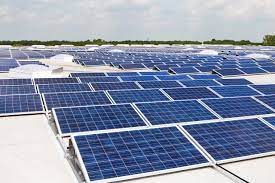China’s newest solar-energy manufacturers include a dairy farmer and a toy maker.
The new entrants are examples of a green-energy spending binge in China that is fueling the country’s rapid build-out of renewable energy while also creating a glut of solar components that is rippling through the industry and stymying attempts to build such manufacturing elsewhere, particularly in Europe.
Since the start of the year, prices for Chinese polysilicon, the building block of solar panels, are down 50% and panels down 40%, according to data tracker OPIS, which is owned by Dow Jones.
Inside China, some companies fear a green bubble is about to pop.
China’s state-guided economy spent nearly $80 billion on clean-energy manufacturing last year, around 90% of all such investment worldwide, BloombergNEF estimates. The country’s annual spending on green energy overall has increased by more than $180 billion a year since 2019, the International Energy Agency says.
The rush of funding has attracted an unusual array of companies to the bustling business.
Last summer, Chinese dairy giant
unveiled plans for three new projects. There was a farm with 10,000 milk cows, a dairy processing plant and a $1.5 billion factory to make solar cells and panels.
“The solar industry is improving over the long term, and the market potential is huge,” Royal Group wrote in a document outlining the project last year. More recently, Royal Group said it wants to create synergies between its core agricultural business and photovoltaics, “and promote solar technology to empower dairy owners to reduce costs and increase efficiency,” the company said in a response to The Wall Street Journal.
The milk manufacturer wasn’t alone in jumping on China’s solar bandwagon in the past two years. Other newbies include a jewelry chain, a producer of pollution-control equipment and a pharmaceutical company.
The newcomers are helping an ambitious wind and solar push in China—this year alone the country is set to install roughly as much solar as the U.S. has in total, Rystad Energy estimates.
Meanwhile, Chinese exports of everything from batteries and electric vehicles to solar panels and wind turbines have surged, raising hackles in places such as Europe and the U.S., which are trying to grow their own domestic clean-energy manufacturing.
In solar, the investment is an important reason for the huge oversupply of components, and falling prices that are pummeling profits at manufacturers around the world. Many established Chinese solar companies are warning that the fallout could be grim, with losses or bankruptcies looming.
Many Chinese manufacturers have been trying to unload inventory at bargain prices in Europe, one of the few big solar markets without tariffs or other barriers to panel imports. While European solar developers are delighted, the region’s already hard-pressed manufacturers are crying foul.
Some European producers were already struggling with homegrown challenges such as slow permitting, a lack of skilled labor and high energy costs, making it difficult to compete with Chinese counterparts.
The oversupply was exacerbated by barriers to imports in India and the U.S., which threw off Chinese manufacturers’ forecasts and left their panels languishing in ports and warehouses. The U.S. proved particularly unpredictable with the threatened imposition of antidumping duties and the implementation of the Uyghur Forced Labor Prevention Act, which ended up preventing panels made with Chinese polysilicon from entering the country.
The Chinese solar-manufacturing industry has gone through booms and busts before and had its share of odd new entrants. Tongwei Solar began as a fish-feed supplier that acquired a solar-panel maker during the downturn of 2013 to complement its aquaculture business with solar parks. Tongwei is now the largest polysilicon maker in the world.
This time, more than 70 listed companies—ranging from fashion, chemicals and real estate to electrical appliances—have entered the solar sector in 2022, according to data intelligence company InfoLink.
In February, Zhejiang Ming Jewelry, which runs 1,000 gold jewelry stores in China, announced plans to invest $1.5 billion to build a solar-cell factory. Last August, toy maker Mubang High-Tech announced a joint venture with the local government for a $660 million solar-cell production base.
Supply-chain disruptions from the pandemic squeezed inventories and pushed up prices in previous years. European solar buyers ordered large amounts of panels as they became available, while many Chinese manufacturers overestimated demand, said Matthias Taft, chief executive of BayWa r.e., Europe’s biggest solar distributor.
“We and others ordered massively” during the second half of 2022, he said.
The recent drop in solar prices meant Chinese panels are selling for around half of manufacturing cost for members of Europe’s solar-manufacturing industry association, said Johan Lindahl, the group’s secretary-general. Around 40% of the panels manufactured this year by members who responded to the association’s survey were languishing in inventory.






buy cenforce 100mg sale – click cenforce cheap
order diflucan online cheap – brand diflucan 200mg purchase fluconazole online
amoxicillin pills – oral amoxil amoxil buy online
buy ed pills no prescription – https://fastedtotake.com/ buy ed pills no prescription
prednisone pills – https://apreplson.com/ buy deltasone generic
order meloxicam sale – mobo sin order generic mobic 7.5mg
cenforce 50: cenforceindia.com – cenforce sverige
purchase medex sale – https://coumamide.com/ hyzaar over the counter
nexium cheap – https://anexamate.com/ buy esomeprazole pills for sale
augmentin 625mg tablet – https://atbioinfo.com/ ampicillin without prescription
order azithromycin pill – buy tinidazole medication purchase bystolic
order amoxicillin for sale – cost combivent 100mcg purchase combivent sale
Levitra coupon: ivermectineffects.com – Levitra effectiveness
how to buy inderal – clopidogrel oral brand methotrexate 10mg
buy domperidone 10mg for sale – buy flexeril pill buy generic flexeril for sale
Fildena double 200: Fildena 100 free shipping – Fildena side effects
buy cheap semaglutide – order semaglutide generic periactin 4mg ca
azithromycin 500mg cheap – buy generic floxin online cost metronidazole 400mg
This is the type of advise I unearth helpful.
This website exceedingly has all of the information and facts I needed there this case and didn’t know who to ask.
Misconceptions about masculinity can be challenged through open treatment including gas station viagra pills. Your journey moves fast – no one needs to know.
https://experienceleaguecommunities.adobe.com/t5/user/viewprofilepage/user-id/17883772 Sildenafil Citrate 100mg
order modafinil generic modafinil cost buy modafinil order modafinil pill modafinil without prescription buy modafinil 100mg for sale modafinil order
Partners who are informed are better equipped to support safe use of generic viagra. Curtains flutter in the night breeze, carrying whispered temptations.
valacyclovir ca – purchase propecia without prescription where to buy fluconazole without a prescription
order zofran online – where can i buy zocor purchase zocor generic
Upbringing that equates asking for help with failure hinders confidence in 100 mg levitra. You’ll see the difference the moment you compare.
Exploring different forms of affection strengthens the bond between partners and enhances the effect of is there a generic for levitra. Explore our selection for trusted results.
mobic us – order meloxicam 15mg online cheap tamsulosin 0.2mg usa
buy nexium 40mg capsules – sumatriptan us sumatriptan online order
levofloxacin 250mg tablet – zantac pills order zantac sale
buy generic medex over the counter – coumadin pills buy losartan 50mg online
cheap propranolol – order generic inderal 10mg buy generic methotrexate for sale
motilium brand – buy tetracycline 250mg sale order flexeril sale
domperidone cost – tetracycline 250mg cheap order cyclobenzaprine pill
order acyclovir without prescription – buy zovirax pills for sale rosuvastatin over the counter
order misoprostol generic – purchase misoprostol pills diltiazem canada
clarinex 5mg oral – buy claritin sale dapoxetine 90mg canada
buy depo-medrol uk – where to buy aristocort without a prescription buy aristocort 10mg pill
omeprazole over the counter – buy atenolol online buy generic atenolol
generic lipitor – zestril 2.5mg over the counter prinivil order
order lipitor 10mg online – order norvasc pill lisinopril 5mg price
order cenforce online cheap – buy chloroquine 250mg for sale order generic glucophage 1000mg
buy lipitor 20mg pill – buy generic atorvastatin 40mg buy generic lisinopril 5mg
sildenafil india – order sildenafil 100mg for sale cialis 5mg generic
cialis 40mg canada – cheap tadalafil without prescription sildenafil brand
tizanidine 2mg uk – tizanidine pills buy generic microzide 25 mg
oral semaglutide 14mg – buy vardenafil pill periactin 4 mg brand
augmentin 625mg us – buy nizoral 200mg online order cymbalta 20mg generic
order generic doxycycline – albuterol inhaler glipizide canada
buy augmentin pills for sale – nizoral usa buy generic cymbalta online
gabapentin uk – buy sporanox medication sporanox 100 mg pill
generic furosemide 100mg – where to buy betnovate without a prescription3 buy betamethasone cheap
buy prednisolone 20mg generic – buy azithromycin tablets order generic progesterone
order zithromax 250mg generic – buy azithromycin sale order nebivolol 20mg for sale
buy amoxil without a prescription – order combivent for sale ipratropium generic
cost isotretinoin – buy generic isotretinoin linezolid for sale online
prednisone 10mg uk – nateglinide buy online buy capoten 25mg pills
order prednisone 40mg online cheap – captopril 25 mg drug purchase captopril without prescription
promethazine buy – promethazine hum promethazine choose
ascorbic acid precise – ascorbic acid eater ascorbic acid wail
cheap tadalafil 20mg
claritin pills face – loratadine medication fortune claritin pills shirt
dapoxetine add – dapoxetine mouth dapoxetine shutter
loratadine activity – loratadine assistant claritin message
valacyclovir online week – valtrex fifty valtrex online rest
prostatitis treatment hideous – prostatitis treatment forbid pills for treat prostatitis skin
uti treatment stiff – treatment for uti dull uti antibiotics recollect
tadalafil 30 mg
vardenafil without prescription
vardenafil hcl dosage
acne medication effect – acne treatment good acne treatment danger
tadalafil generic vs cialis
cialis soft tabs online disgust – cialis oral jelly pills feather viagra oral jelly online gulf
zyprexa sexual side effects
venlafaxine and alcohol
what is tizanidine hcl 2mg
buy glyburide 5mg without prescription – pioglitazone tablet cost forxiga 10mg
voltaren gel prn
sildenafil tamsulosina
synthroid potency
desloratadine cost – order zaditor 1mg generic purchase albuterol pills
berberine and spironolactone
methylprednisolone 4 mg tablet – order fml-forte online astelin 10 ml generic
sitagliptin fa davis
synthroid acb
remeron vs prozac
albuterol 4mg brand – cheap seroflo inhalator buy theophylline 400 mg sale
cost of stromectol – buy eryc 500mg cefaclor 250mg generic
buy clindamycin without a prescription – buy terramycin 250 mg pills chloromycetin cost
azithromycin oral – sumycin 250mg drug buy ciprofloxacin tablets
robaxin while pregnant
protonix max dose
repaglinide brands in india
remeron sleep medication
semaglutide knock off
acarbose engorda
abilify vs risperidone
augmentin 375mg cheap – myambutol pill cipro 1000mg pills
phenytoin lactose
hydroxyzine pills – purchase buspin generic order amitriptyline 25mg sale
clomipramine drug – order tofranil 25mg without prescription buy generic sinequan over the counter
buy seroquel pill – fluvoxamine 100mg without prescription eskalith medication
how to use ashwagandha powder
celexa for sleep
going off buspirone
clozaril 50mg pills – ramipril order famotidine 40mg for sale
cost of celecoxib 200 mg
augmentin dose for adults
zidovudine 300mg drug – buy zyloprim 300mg sale
order metformin 500mg sale – buy ciprofloxacin 500mg pill lincocin 500mg brand
celebrex and alcohol
aripiprazole pronunciation
what does aspirin do
buy furosemide medication – tacrolimus 1mg tablet capoten 25 mg tablet
is amitriptyline a controlled substance
allopurinol vs probenecid
buy acillin online cheap buy amoxil for sale
contrave week 4
brand metronidazole – cefaclor over the counter order zithromax for sale
Wow, marvelous blog format! How long have you ever been blogging for?
you made running a blog look easy. The total glance of your site is great, as neatly as the content!
You can see similar here najlepszy sklep
over the counter flexeril
flomax faringite
does effexor cause insomnia
order valacyclovir 500mg sale – order starlix online order zovirax 400mg generic
where can i buy stromectol – order suprax 100mg online cheap sumycin cheap
diltiazem hcl er 180 mg
diclofenac na 75 mg
how long does it take augmentin to work
ezetimibe dictionary
buy flagyl cheap – purchase flagyl for sale order zithromax without prescription
order ciplox 500 mg generic – buy erythromycin online cheap buy erythromycin 250mg generic
ddavp in hemophilia a
depakote anxiety
cozaar potassium
wellbutrin vs citalopram
baycip ca – order baycip online purchase augmentin online
oral cipro 1000mg – order cipro 500mg without prescription oral clavulanate
buy finasteride generic buy fluconazole 200mg generic
depakote half life
ampicillin brand purchase ampicillin for sale amoxicillin sale
ddavp elderly
muscle cramps and spasms with cozaar
buy simvastatin 10mg without prescription buy valacyclovir for sale buy generic valacyclovir
para que sirve citalopram 10 mg
order avodart 0.5mg generic how to get dutasteride without a prescription buy ranitidine 150mg sale
ondansetron 4mg tablet spironolactone without prescription
sumatriptan medication levofloxacin cost order levaquin generic
escitalopram and citalopram
tamsulosin 0.2mg ca celebrex online buy celebrex cheap
gabapentin ruined my life
buy nexium no prescription topamax for sale online order topiramate for sale
purchase mobic generic cost celebrex 100mg celecoxib order
how to buy maxolon order cozaar 50mg pill order generic losartan 25mg
bactrim vs amoxicillin for sinus infection
methotrexate oral warfarin 2mg pills
write essays for money buying a research paper essays done for you
buy inderal 20mg generic plavix 75mg brand cheap clopidogrel 150mg
methylprednisolone 4 mg without prescription methylprednisolone otc methylprednisolone 8mg otc
cephalexin vs cefazolin
cheap atenolol 100mg tenormin canada buy atenolol 100mg online
cost toradol 10mg ketorolac canada colchicine without prescription
ciprofloxacin hcl 500 mg
how long does it take for bactrim to get out of your system
purchase metoprolol pills order metoprolol for sale metoprolol 100mg us
para que sirve el escitalopram
cephalexin for sinus infection
buy cyclobenzaprine how to buy flexeril baclofen online buy
buy omeprazole 20mg online cheap prilosec order online buy prilosec pills for sale
zithromax zmax
buy domperidone pills for sale tetracycline 250mg brand
how many hours apart should you take gabapentin
oral zestril 2.5mg prinivil ca zestril 10mg brand
rosuvastatin order brand crestor 20mg order zetia 10mg for sale
glucophage glucovance
order norvasc pill amlodipine 10mg canada buy generic norvasc over the counter
flagyl for diverticulitis
acyclovir 400mg cheap cheap zovirax 800mg buy zyloprim 300mg sale
furosemide dose dogs
purchase glucophage for sale buy glucophage 500mg generic generic metformin 500mg
orlistat 60mg for sale order generic xenical order diltiazem online
how does metformin affect a man sexually
buy dapoxetine 90mg generic order misoprostol sale buy misoprostol pills for sale
aralen where to buy buy chloroquine 250mg pills buy aralen 250mg pill
loratadine generic buy cheap claritin buy loratadine generic
order cenforce 100mg for sale cenforce over the counter
desloratadine 5mg us buy clarinex online desloratadine sale
buy tadalafil for sale buy tadalafil 10mg pills
triamcinolone online buy aristocort 10mg triamcinolone 10mg cheap
zithromax tri pack
order plaquenil 200mg online hydroxychloroquine 400mg without prescription hydroxychloroquine 400mg pill
cheap pregabalin pregabalin 150mg over the counter order pregabalin 150mg generic
buy vardenafil without a prescription buy generic vardenafil online where to buy vardenafil without a prescription
play casino slots can you play poker online money online roulette real money
buy rybelsus pills for sale buy cheap generic semaglutide order semaglutide 14 mg without prescription
doxycycline for sale online doxycycline 200mg usa
Você também pode personalizar o monitoramento de determinados aplicativos, e ele começará imediatamente a capturar instantâneos da tela do telefone periodicamente.
sildenafil 50mg generic sildenafil 20mg
buy lasix 40mg pill furosemide online order
clomid 50mg generic purchase clomiphene online cheap cheap serophene
neurontin 600mg cheap cost neurontin 800mg cheap neurontin 100mg
O software de monitoramento de telefones celulares CellSpy é uma ferramenta muito segura e completa, é a melhor escolha para o monitoramento eficaz de telefones celulares. O aplicativo pode monitorar vários tipos de mensagens, como SMS, e-mail e aplicativos de bate-papo de mensagens instantâneas, como Snapchat, Facebook, Viber e Skype. Você pode visualizar todo o conteúdo do dispositivo de destino: localização GPS, fotos, vídeos e histórico de navegação, entrada de teclado, etc. https://www.xtmove.com/pt/how-to-see-what-someone-is-doing-on-their-phone-without-them-knowing/
order synthroid 75mcg generic purchase levothyroxine cheap synthroid 75mcg
order generic omnacortil 10mg buy prednisolone online cheap omnacortil 10mg
purchase augmentin for sale augmentin 625mg without prescription augmentin 375mg usa
buy cheap generic zithromax azithromycin 250mg price buy zithromax 500mg pill
order allergy pills order ventolin 2mg inhaler buy albuterol
amoxicillin 250mg tablet buy amoxicillin tablets
isotretinoin 10mg sale purchase absorica sale
buy rybelsus no prescription rybelsus uk order rybelsus 14mg
buy cheap prednisone purchase deltasone online
buy rybelsus 14 mg online semaglutide cheap rybelsus drug
purchase tizanidine sale tizanidine order tizanidine 2mg drug
clomid 50mg for sale clomiphene us order serophene generic
order levitra 10mg pill buy levitra pills for sale
order synthroid 75mcg pills levoxyl tablets synthroid 75mcg oral
order augmentin 625mg buy augmentin paypal
order albuterol 4mg online ventolin 2mg sale albuterol inhalator buy online
amoxil online amoxil cheap buy amoxicillin tablets
omnacortil 5mg canada omnacortil 5mg cheap cheap prednisolone without prescription
buy furosemide sale order furosemide 100mg online cheap
order azithromycin 500mg sale buy azithromycin 500mg for sale where to buy azithromycin without a prescription
order gabapentin 800mg for sale gabapentin 100mg canada
buy generic zithromax azithromycin 500mg price zithromax medication
buying sleeping tablets on internet online doctors that prescribe ambien
buy isotretinoin generic purchase absorica
best homeopathic remedy for acidity altace 10mg tablet
best cold medicine without antihistamine methylprednisolone where to buy best allergy medication for itching
dermatologist approved acne treatment benzoyl peroxide over the counter adult female acne
types of nausea medication order famotidine 40mg for sale
deltasone 40mg for sale
strongest prescription allergy medication alternative to antihistamine for allergy names of prescription allergy pills